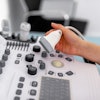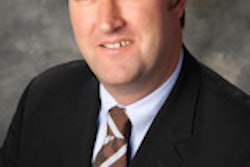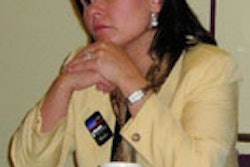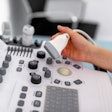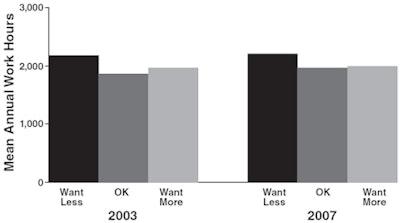
The radiology employment market tipped from a shortage to a surplus in 2007, leaving radiologists hungry for more work, according to a new study to be published in the American Journal of Roentgenology. Why? Because imaging departments are increasingly productive and the workload hasn't caught up, researchers found.
"The amount of procedures radiologists can do per hour has gone up," said Jonathan Sunshine, one of the authors of the study and a senior director of research technology at the American College of Radiology (ACR). "Technology like soft-copy reading of cross-sectional studies and the ability to read through successive parallel planes rather than having to shift one's eyes left to right across a sheet of film have increased individual radiologists' productivity."
In 2007, radiologists sought an average 3.3% increase in workload, in contrast to 2003, when desire for more work and less work were about equal, according to Sunshine and colleagues from the University of California, San Francisco and Johns Hopkins University in Baltimore (AJR, March 2010, Vol. 194:3, pp. 697-703).
The study used data from the ACR's 2007 Survey of Diagnostic Radiologists, which consisted of an e-mailed survey of 487 practicing ACR-member radiologists (response rate, 20%); participants were asked how their actual workload and income compared with what they desired. The team then compared the findings to a similar report the ACR had made in 2003.
Radiologists wanted 65 more work hours annually, the study found. Ten percent of survey participants said they wanted less work, and 20% wanted more; those who wanted less sought a 20% decrease in workload, while those who wanted more sought a 26% increase. Average desired decrease and increase in annual work hours were 463 and 544, respectively.
Radiologists who wanted less work averaged a current workload of 2,300 hours annually, more than the average of 2,050 hours worked by radiologists happy with their current workload. Those who wanted to work more averaged a current workload of about 2,100 hours annually.
 |
| Percentage of radiologists desiring change in workload. Desire for more work and less work were approximately equal in 2003, but in 2007, twice as many radiologists wanted more work as wanted less work. Images courtesy of the American Roentgen Ray Society. |
 |
| Mean current annual work hours by desired work change. Those wanting less work were working significantly longer hours than were those not seeking change. However, those wanting more work were not working shorter hours than those not seeking change. |
To the team's surprise, the study results indicate that radiologists who wanted more work were not working fewer hours than those who said their workload was just right.
"It's not necessarily the person working shorter hours who wants more work," Sunshine said.
Generalists work less?
The study found that the 19% of radiologists who were not subspecialized were working less, averaging just under 1,900 hours each year, compared to the 2,100 hours subspecialist radiologists were working annually.
There were also differences across subspecialties. For example, 51% of abdominal radiologists wanted more work, while only 5% wanted less, and 35% of pediatric radiologists wanted less work, and no respondents in this category wanted more.
Work environments and socioeconomic factors influenced radiologists' desire for more or less work as well, the study found:
- In government practice, 57% of radiologists wanted an increase in workload; none wanted a decrease. The average desired workload increase was 26%, or 496 hours per year.
- Radiologists practicing in large urban settings wanted, on average, a 6.4% increase in workload; those working in smaller urban areas didn't want their workload to change at all.
- Radiologists in the Midwest and West, on average, did not want their workload to change. Those practicing in the Northeast wanted 7.1% more work, or 150 hours per year.
- Radiologists older than 65 sought a decrease in annual workload of about 182 hours more than 45- to 54-year-old radiologists.
- Male radiologists wanted to increase their workload by 115 hours more than did female radiologists.
- Radiologists in large practices (more than 21 members) wanted, on average, 96 more hours of work per year than did their counterparts practicing in midsized groups (11 to 20 members).
Work hours and vacation weeks of full-time radiologists,
by practice type
|
|||||||||||||||||||||||||||||||||||
| Note: Except where noted otherwise, all data are shown as mean (standard error). No. = unweighted number of responses. Table courtesy of the American Roentgen Ray Society. |
Why the 'surplus'?
The fact that in 2007 radiologists wanted more work doesn't mean that 3% of radiologists were unemployed, according to the study. What's happening is that radiologists have become more efficient and able to do more work in one work hour -- due to new technologies such as PACS and 2D and 3D visualization techniques -- but the workload hasn't increased as fast.
And the desire for more work may be affected by changes in payment rates, family structure and responsibilities, or the general U.S. economy, making surplus or shortage not dependent solely on the number of radiologists in this country, their hourly productivity, and the amount of work available, the team wrote.
The long and short of it? The employment market seems to self-correct relative shortages and surpluses in individual geographic areas and subspecialties within a few years, according to the study team.
"Our advice to radiologists is to choose the subspecialties and jobs that attract them, both because it is likely to be more satisfying and because the pattern of opportunities changes over periods of only a few years," they wrote.
By Kate Madden Yee
AuntMinnie.com staff writer
February 19, 2009
Related Reading
RIS improves productivity -- but it depends on the modality, October 7, 2009
AJR: Radiologists work longer hours, but get more vacation, September 24, 2009
PACS drives 70% growth in radiologist productivity, study finds, June 18, 2009
Wii remote, Baroque music can lighten the load in reading rooms, April 28, 2009
PACS boosts productivity, reporting times, April 24, 2008
Copyright © 2010 AuntMinnie.com




